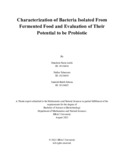| dc.contributor.advisor | Hossain, M. Mahboob | |
| dc.contributor.author | Archi, Shucheta Nazia | |
| dc.contributor.author | Tabassum, Nafisa | |
| dc.contributor.author | Juhana, Juairiah Bakth | |
| dc.date.accessioned | 2024-01-15T04:50:47Z | |
| dc.date.available | 2024-01-15T04:50:47Z | |
| dc.date.copyright | 2023 | |
| dc.date.issued | 2023-08 | |
| dc.identifier.other | ID 19136016 | |
| dc.identifier.other | ID 18236018 | |
| dc.identifier.other | ID 19136025 | |
| dc.identifier.uri | http://hdl.handle.net/10361/22148 | |
| dc.description | This thesis is submitted in partial fulfillment of the requirements for the degree of Bachelor of Science in Biotechnology 2023. | en_US |
| dc.description | Catalogued from PDF version of thesis. | |
| dc.description | Includes bibliographical references (pages 53-56). | |
| dc.description.abstract | This study aimed to isolate and biochemically characterize bacteria that are not exclusively LABs from popular fermented food products and evaluate their potential to be probiotics. As primary screening, isolated bacterial colonies were tested for antagonism against seven laboratory stains (LS) of enteric or infectious bacteria using three methods: spot-on-lawn with direct bacterial colonies, disk diffusion and well diffusion with cell-free supernatant (CFS). Biochemical tests, morphological observation and growth on selective media were used to characterize the potential antagonistic bacteria and their survivability in GI-tract conditions was determined by culturing in different media modified with bile salts and acid. Antibiotic susceptibility tests in the presence of ten different antibiotics were performed to study their resistance or susceptibility. Their potential for pathogenicity was tested via hemolysis test on blood agar and DNase test on DNase agar. Although a total of eight isolates showed signs of antagonism via a competitive advantage and/or inhibition of some of the LSs, most of them tested positive for hemolytic activity deeming them potentially harmful. Two of the bacteria that were isolated from yogurt showed no apparent sign of pathogenicity and survived well in high concentrations of bile salts as well as acidic pH. They were presumed to be Pediococcus and Paenibacillus type of bacteria which had shown antagonism against Shigella flexneri and Salmonella typhi respectively. Overall, further molecular-level research is necessary to understand the true identity and probiotic potential of the isolated bacteria. | en_US |
| dc.description.statementofresponsibility | Shucheta Nazia Archi | |
| dc.description.statementofresponsibility | Nafisa Tabassum | |
| dc.description.statementofresponsibility | Juairiah Bakth Juhana | |
| dc.format.extent | 76 pages | |
| dc.publisher | Brac University | en_US |
| dc.rights | Brac University theses are protected by copyright. They may be viewed from this source for any purpose, but reproduction or distribution in any format is prohibited without written permission. | |
| dc.subject | Fermented food | en_US |
| dc.subject | Probiotics | en_US |
| dc.subject | Antagonism | en_US |
| dc.subject | Hemolysis | en_US |
| dc.subject | Enteric bacteria | en_US |
| dc.subject.lcsh | Pathogenicity | |
| dc.title | Characterization of bacteria isolated from fermented food and evaluation of their potential to be probiotic | en_US |
| dc.type | Thesis | en_US |
| dc.contributor.department | Department of Mathematics and Natural Sciences, Brac University | |
| dc.description.degree | B. Biotechnology | |

